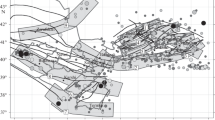Abstract
The paper presents the results of modeling the stress–strain state of the epicentral zone of the strong crustal Hanshin–Awaji earthquake, which occurred in the area of Kobe (Japan) on January 17, 1995, with a magnitude M of 6.9. In this work the author’s method for modelling and analyzing the stress–strain state of the epicentral zones of crustal earthquakes was used. The geological, tectonic, and seismological data for the earthquake region are used as input data and boundary conditions for modeling. In this work it is shown that the main rupture arising at the origin of the earthquake is generated in a zone of high stress intensity at a certain ratio of the main tectonic stresses and propagates through areas of anomalously high stress concentration, causing maximum displacements in these zones. The results provide new insights into the focal mechanism of an earthquake, aimed at predicting the location and magnitude of strong crustal earthquakes in earthquake-prone areas.




Similar content being viewed by others
REFERENCES
V. H. Benioff, in Weak Earthquakes (Moscow, 1961), pp. 211–219 [in Russian].
M. V. Gzovskii, in Tectonophysical Problems (Gosgeolizdat, Moscow, 1960), pp. 78–89 [in Russian].
V. Yu. Zabrodin, O. V. Rybas, and G. Z. Gil’manova, Fault Tectonics of the Continent Part of Russian Far East (Dal’nauka, Vladivostok, 2015) [in Russian].
V. N. Morozov, V. I. Kaftan, V. N. Tatarinov, I. Yu. Kolesnikov, A. I. Manevich, and A. Yu. Melnikov, Geotectonics 52 (5), 578 (2018). https://doi.org/10.1134/S0016852118040064
V. N. Morozov, V. N. Tatarinov, I. Yu. Kolesnikov, and A. I. Manevich, Izv., Phys. Solid Earth 54 (4), 602–612 (2018). https://doi.org/10.1134/S1069351318040080
V. N. Morozov, V. N. Tatarinov, and A. I. Manevich, J. Volcanol. Seismol. 14 (2), 105–115 (2020). https://doi.org/10.1134/S0742046320020049
S. I. Sherman, S. A. Seminskii, S. A. Bornyakov, V. Yu. Buddo, R. M. Lobatskaya, A. N. Adamovich, V. A. Truskov, and A. A. Babichev, Fault Formation in the Lithosphere: Displacement Zones (Nauka, Novosibirsk, 1992) [in Russian].
Y. Guo, K. Koketsu, and T. Ohno, Earth, Planets Space 65 (12), 1581–1586 (2013). https://doi.org/10.5047/eps.2013.07.006
H. Kanamori, Annu. Rev. Earth Planet. Sci. 22, 207–237 (1994). https://doi.org/10.1146/annurev.ea.22.050194.001231
Y. Kanamori and S. I. Kawakami, Eng. Geol. 43, 135–150 (1996). https://doi.org/10.1016/0013-7952(96)00056-7
M. Hashimoto, T. Sagiya, H. Tsuji, Y. Hatanaka, and T. Tada, J. Phys. Earth 44 (4), 255–279 (1996). https://doi.org/10.4294/jpe1952.44.255
T. L. Holzer, Geol. Soc. Am. 5 (8), 153–155, 165–167 (1995).
D. L. Wells and K. J. Coppersmith, Bull. Seismol. Soc. Am. 84 (4), 974–1002 (1994).
H. Yamanaka, Y. Hiramatsu, and H. Katao, Earth, Planets Space 54, 933–945 (2002). https://doi.org/10.1186/BF03352441
ACKNOWLEDGMENTS
We are thankful for equipment and materials provided by the Center for Collective Use “Analytical Center for Geomagnetic Data” of the Geophysical Center, Russian Academy of Sciences (http://ckp.gcras.ru/).
Funding
This work was performed within a State Assignment for the Geophysical Center, Russian Academy of Sciences, approved by the Ministry of Education and Science of Russia.
Author information
Authors and Affiliations
Corresponding author
Additional information
Translated by M. Hannibal
Rights and permissions
About this article
Cite this article
Morozov, V.N., Manevich, A.I. Mechanism of Rupture Formation of the Hanshin–Awaji Earthquake (Kobe, Japan) January 17, 1995, M 6.9. Dokl. Earth Sc. 499, 654–660 (2021). https://doi.org/10.1134/S1028334X21080080
Received:
Revised:
Accepted:
Published:
Issue Date:
DOI: https://doi.org/10.1134/S1028334X21080080




